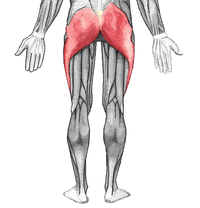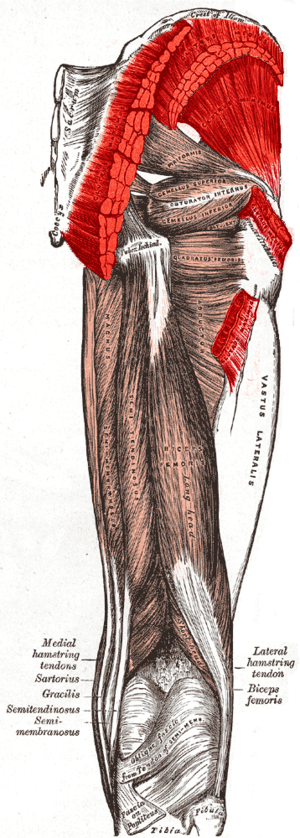
Gluteal muscles
Encyclopedia

Buttocks
The buttocks are two rounded portions of the anatomy, located on the posterior of the pelvic region of apes and humans, and many other bipeds or quadrupeds, and comprise a layer of fat superimposed on the gluteus maximus and gluteus medius muscles. Physiologically, the buttocks enable weight to...
: the gluteus maximus muscle
Gluteus maximus muscle
The gluteus maximus is the largest and most superficial of the three gluteal muscles...
, gluteus medius muscle
Gluteus medius muscle
The gluteus medius , one of the three gluteal muscles, is a broad, thick, radiating muscle, situated on the outer surface of the pelvis....
and gluteus minimus muscle
Gluteus minimus muscle
The gluteus minimus , the smallest of the three gluteal muscles, is situated immediately beneath the gluteus medius.-Origin and insertion:...
.
The gluteal muscles
The gluteus maximus is the largest of the gluteal muscleMuscle
Muscle is a contractile tissue of animals and is derived from the mesodermal layer of embryonic germ cells. Muscle cells contain contractile filaments that move past each other and change the size of the cell. They are classified as skeletal, cardiac, or smooth muscles. Their function is to...
s and one of the strongest muscles in the human
Human
Humans are the only living species in the Homo genus...
body
Human anatomy
Human anatomy is primarily the scientific study of the morphology of the human body. Anatomy is subdivided into gross anatomy and microscopic anatomy. Gross anatomy is the study of anatomical structures that can be seen by the naked eye...
. It inserts at the iliotibial band and the gluteal tuberosity of the femur
Femur
The femur , or thigh bone, is the most proximal bone of the leg in tetrapod vertebrates capable of walking or jumping, such as most land mammals, birds, many reptiles such as lizards, and amphibians such as frogs. In vertebrates with four legs such as dogs and horses, the femur is found only in...
. Its action is to extend and to laterally rotate the hip, and also to extend the trunk.
Problems associated with the gluteal muscles

The bulk of the gluteal muscle mass contributes only partially to shape of the buttocks. The other major contributing factor is that of the panniculus adiposus
Panniculus adiposus
The panniculus adiposus is the fatty layer of the subcutaneous tissues, superficial to a deeper vestigial layer of muscle, the panniculus carnosus.It includes structures that are considered fascia by some sources but not by others....
of the buttocks, which is very well developed in this area, and gives the buttock its characteristic rounded shape. Although the gluteal muscle bulk and tone can be improved with massage and exercise, it is the disposition of the overlying panniculus adiposus which may be responsible for the "sagging butt" phenomenon. Exercise in general (not only of the gluteal muscles but of the body in general) which can contribute to fat loss can lead to reduction of mass in subcutaneal fat storage locations on the body which includes the panniculus, so for leaner and more active individuals, the glutes will more predominantly contribute to the shape than someone less active with a fattier composition. The degree of body fat stored in various locations such as the panniculus is dictated by genetic and hormonal profiles.
Treatment
Studies have shown that exercise and massage are effective at reversing and protecting against atrophyAtrophy
Atrophy is the partial or complete wasting away of a part of the body. Causes of atrophy include mutations , poor nourishment, poor circulation, loss of hormonal support, loss of nerve supply to the target organ, disuse or lack of exercise or disease intrinsic to the tissue itself...
of these muscles.
Poisoning by eating Lathyrus sativus
Lathyrus sativus
Lathyrus sativus, is a legume commonly grown for human consumption and livestock feed in Asia and East Africa. It is a particularly important crop in areas that are prone to drought and famine, and is thought of as an 'insurance crop' as it produces reliable yields when all other crops...
Indian Pea or khesari dhal will lead to emaciation of buttock muscles (Neurolathyrism).
Exercise and stretching
Any exercise that works and/or stretches the buttocks is suitable, for example lungesLunge (exercise)
The lunge is a strength training exercise that is used to strengthen the quadriceps muscles, gluteal muscles and the muscles comprising the "hamstrings", the semitendinosus, the semimembranosus, and the biceps femoris...
, climbing stairs, fencing
Fencing
Fencing, which is also known as modern fencing to distinguish it from historical fencing, is a family of combat sports using bladed weapons.Fencing is one of four sports which have been featured at every one of the modern Olympic Games...
, bicycling, rowing, squat
Squat (exercise)
In strength training, the squat is a compound, full body exercise that trains primarily the muscles of the thighs, hips and buttocks, quads , hamstrings, as well as strengthening the bones, ligaments and insertion of the tendons throughout the lower body...
s, arabesque, aerobics
Aerobics
Aerobics is a form of physical exercise that combines rhythmic aerobic exercise with stretching and strength training routines with the goal of improving all elements of fitness...
, and various specific exercises for the bottom.
Powerlifting
Powerlifting
Powerlifting is a strength sport. It resembles the sport of Olympic weightlifting, as both disciplines involve lifting weights in three attempts. Powerlifting evolved from a sport known as 'odd lifts' which followed the same three attempt format but used a wide variety of events akin to Strongman...
exercises which are known to significantly strengthen the gluteal muscles include the squat
Squat (exercise)
In strength training, the squat is a compound, full body exercise that trains primarily the muscles of the thighs, hips and buttocks, quads , hamstrings, as well as strengthening the bones, ligaments and insertion of the tendons throughout the lower body...
, deadlift
Deadlift
The deadlift is a weight training exercise where a loaded barbell is lifted off the ground from a stabilized, bent over position. It is one of the three canonical powerlifting exercises, along with the squat and bench press.-Overview:...
, leg press
Leg press
The leg press is a weight training exercise in which the individual pushes a weight or resistance away from them using their legs. The term leg press also refers to the apparatus used to perform this exercise...
, feet in squats (chin on chest & stick glutes out) and good mornings
Good-morning
The good-morning is a weight-lifting exercise. The movement resembles bowing to greet someone "good morning". The erector spinae muscles of the lower back work isometrically to keep the spine in an extended position while the hamstrings and gluteus maximus work isotonically to perform hip extension...
(bend over with a bar on the shoulders with a light amount of weight).
External links
- 8b. The Muscles and Fasciæ of the Thigh Bartleby.com, Henry Gray, Anatomy of the Human Body, 1918.

